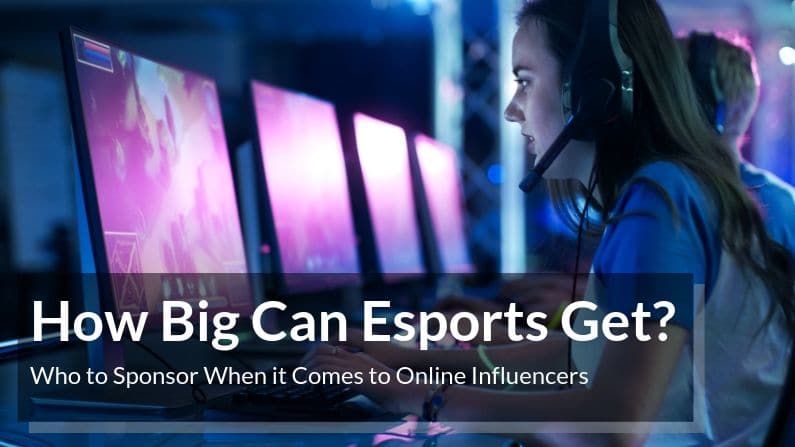From streamers to YouTubers and from professional gamers to full-on esports competitors, there’s a lot to unpack about the world of internet personalities. Since the birth of YouTube in 2005, people have been subscribing to a wide variety of content creators. There are millions of videos on the platform, from people who create content surrounding makeup tutorials to those who focus on gaming. Those who focus on playing video games fall into a few categories:
Let’s Players, Game Reviewers, and Professional Gamers.
All three can produce income through YouTube, but more so in recent years through sponsors. They use a particular product, or dedicate part of their video to the company that is sponsoring.
Let’s Players are a more fun, energetic sort of YouTuber. They focus on simply playing the game, while commenting, screaming, laughing, dancing, and whatever else they feel like doing. They tend to be frank, unafraid of being honest, and very boisterous. Most often, they record beforehand and put their videos up on YouTube after the fact, but on occasion they stream to feel more connected with their fan base.
Game Reviewers are similar to Let’s Players, in that they are frank and honest, but they differ in their goals. Reviewers wish to inform their audience rather than entertain. They cover many smaller details of the game, while, most often, not actually showing their entire playthrough of the content. They present what the pros and cons are of graphics, gameplay, plot, and the overall experience. Game Reviewers tend to be a little more subdued than Let’s Players as well. They record their videos beforehand nearly 100% of the time, as their methods and goals wouldn’t be well suited to streaming.
Professional Gamers are a larger step away from the other two in what they do. They focus on tournaments of various games, winning or losing, and put it up on the YouTube platform, but are not quite as large or serious as esports competitors. A great example of this would be the gamer, Ninja. There are thousands of games that Professional Gamers could focus on, from something as obscure as Qbert to the most popular choices of Overwatch, Apex Legends, or Fortnite. Most of them also stream their matches on Twitch, porting the videos afterward from Twitch onto YouTube.

Source: https://www.youtube.com/user/NinjasHyper/videos
What is an Internet Streamer?
Streamers fall into the first and third general categories, but they serve a different audience. Most are on Twitch, but the YouTube streaming service is also gaining traction with YouTubers who want to reach their fans more directly. Regardless of location, these are live videos that the user is streaming to reach a large audience, sometimes even reaching millions of people.
Twitch is, by and large, the biggest streaming website, having only gotten larger since Amazon bought them back in August of 2014 for $970 million. The service is a platform not only for the individual, however, as many large esports competitions are broadcast on the site.
Why Should Brands Invest in Esports Sponsorships?
Esports, is, for better or for worse, still growing up. Many brands don’t yet know how to categorize the players or measure how effective sponsoring them would be. After all, the category only really gained traction in the late 2000’s, but in 2019, “it is estimated that the total audience of esports will grow to 454 million viewers and that revenues will increase to over US$1 billion.” That number shows a gigantic untapped well of viewers, engagement, potential sponsorship opportunities, and revenue.
Categorizing is imperative for proper demographic information, something Hookit has down pat.
Categorizing Esports
Esports, as far as grouping is concerned, is only referencing the major leagues and tournaments. They are the ones that have teams, organized structure, and often a physical location. A good example of something like that would be the League of Legends World Championship, that has a rotating location worldwide. In 2018, their finals had 99.6 million viewers, a marked increase from the 60 million of the year before. Now, there are even talks about adding an esports section to the 2022 Olympics.
Professional gamers, be they primarily Streamers or YouTubers, are not considered esports athletes in the same way as players in the leagues or big teams would be. They fit into a sub-category, sort of an Individual Esports category, where they sit as a productive, lucrative option, but they are not beholden to the same regulations. They do not have to go to any location in particular, most often playing from home, but they do have a massive audience on Twitch and YouTube on a more consistent basis. So, while they may have a lower overall number of views, there are always going to be views since there’s no season of play.
YouTubers and Streamers as a general category should also not be ignored. They, such as Markiplier or Pewdiepie, have millions of people watching them nearly every day. Each video they post gets over a million views, and Pewdiepie in particular had 20.5M social media interactions in the month of June alone. Through all of Hookit’s rankings, Pewdiepie was number seven in total social interactions among all athletes. At this moment, however, people don’t think of him or his peers when they think of esports marketing options. That could be a major loss.

- As of July 2019, nine years after his YouTube channel was created, Pewdiepie has received over 97 million subscribers and 22 billion video views to date.
- As of June 2019, Markiplier has over 24 million subscribers and 11 billion total video views since 2012.
- As of April 2019, Jacksepticeye has over 22 million subscribers and 10 billion total video views since 2012, and is currently ranked the most-subscribed channel in Ireland.
- As of July 2019, Vegetta777 has over 27 million subscribers and 10.6 billion total video views since 2008.
How to Identify the Most Valuable Esports Players
All of these individuals and more are well within the scope of Hookit’s data and, likewise, within the grasp of savvy companies, whether it be for Esports, Individual Esports/Professional Gaming, YouTubers, or Streamers. In this huge sea of data, Hookit can help brands identify new potential ambassadors and quantify the likely value that partner would have for the brand. That’s sponsorship evolved.


Written by Katarina McCollough
Katarina is a Hookit Marketing Intern and an enthusiastic freelance/content writer freshly out of SDSU with a degree in English. She is interested in all sports, their social influence, as well as technical topics such as coding, but is especially knowledgeable on streamers and esports. She spends her free time writing creative pieces, reading, and drawing.


